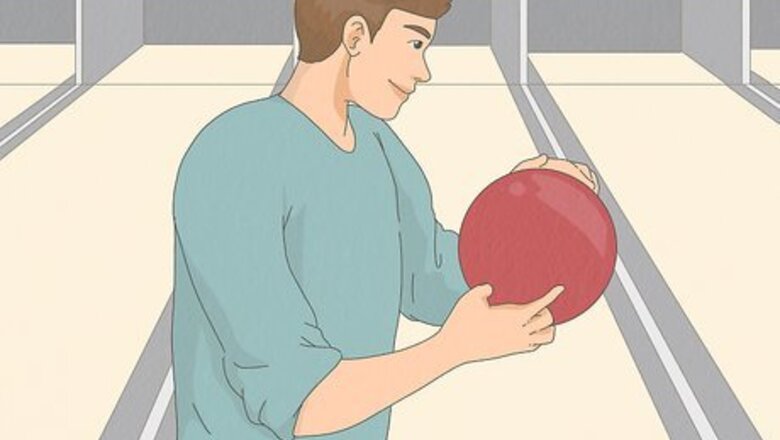
views
Holding the Ball
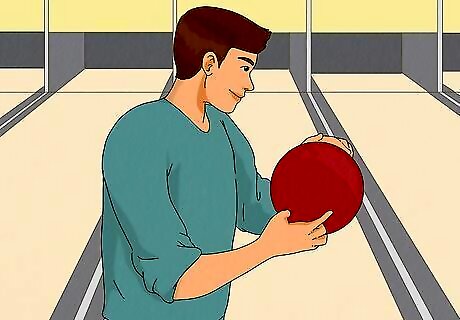
Pick out a ball that's roughly 10% of your body weight. Bowling balls range in weight from 6–16 pounds (2.7–7.3 kg). If you’re smaller in stature or don’t have much experience bowling, it’s best to start with a lighter ball that you can move around with ease until you get the hang of the basic technique. If you weight 140 pounds (64 kg), for example, you would select a 14 lb (6.4 kg) ball to practice with. Heavier balls hit with more force, but they can be difficult to swing and maneuver. On the flipside, lighter balls are easier to manipulate and roll faster, but tend to give up some accuracy.Tip: Different balls also have finger holes of different sizes, so you may need to try out a few in order to find one that offers a proper fit for your fingers.
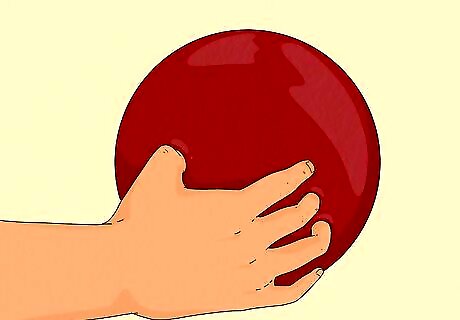
Insert your middle finger, ring finger, and thumb into the holes in the ball. Take hold of the ball with your dominant hand—this is generally the one that you'll be more coordinated with. Slide your fingers in as far as they'll comfortably go and gently squeeze the edges of the holes. Don't jam your fingers in too far. There’s a chance that they could get stuck, especially if you're using a ball that's on the smaller side. This is known as a "conventional" grip. Centering the ball on your hand in this way keeps it evenly balanced and allows for straighter, more precise shots.
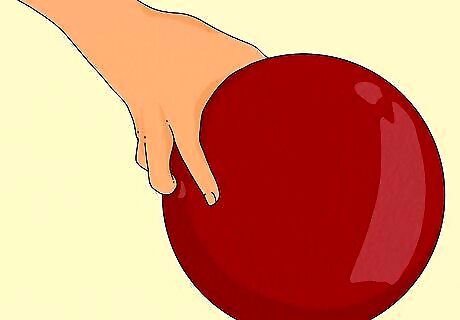
Grip the ball loosely with your dominant hand. Try not to clutch the finger holes like you’re holding on for dear life. Keep your hand firm but relaxed, using only enough pressure as it takes to maintain a good connection with the ball. The more tense your hand is, the more trouble you’ll have getting a nice, smooth release. For the sake of your toes, you don’t want your grip to be too loose, either.
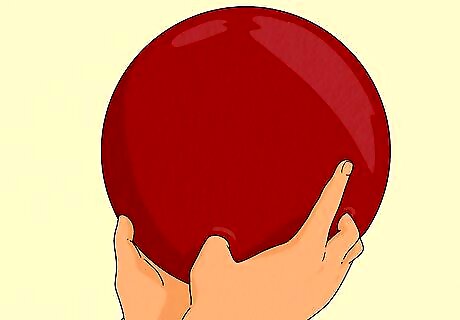
Use your free hand to help support the ball. Place your palm flat against the side of the ball close to the bottom edge. This hand is there to steady the ball during your approach. It will also share the load so your bowling arm doesn't get fatigued as quickly. Always use a two-handed grip when carrying your ball from the return to the lane, as well as to and from the rack where you originally got it.
Making Your Approach
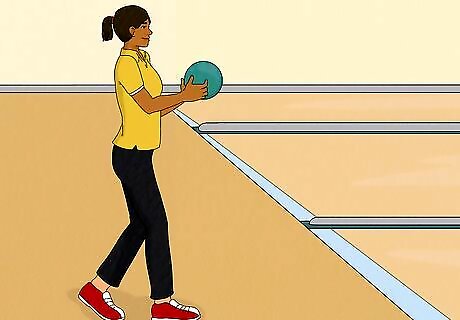
Stand on the approach area and line your body up with the center of the lane. The approach area is the open space just past the ball return where you'll make your walk-up. It serves as a kind of starting point where you can gather up the momentum you need to send the ball down to the far end of the lane, where the pins await. If you're right-handed, it may help to stand slightly left of the midpoint of the lane so that your ball doesn't travel too far to the right. If you're left-handed, shift over to the right. The lane is the oiled strip of wood that you actually roll the ball down.
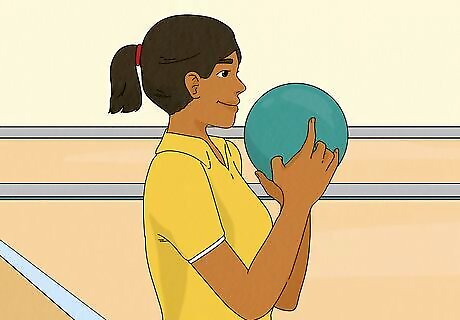
Raise the ball up until it’s poised just under your chin. Keep it in this position until you’re ready to initiate your swing. This serves two purposes—firstly, it allows you to sight the pins over the top of the ball. Secondly, it prevents the ball from bumping into your legs during your walk-up. Hold the ball as close to your body as you can to make its weight more manageable.
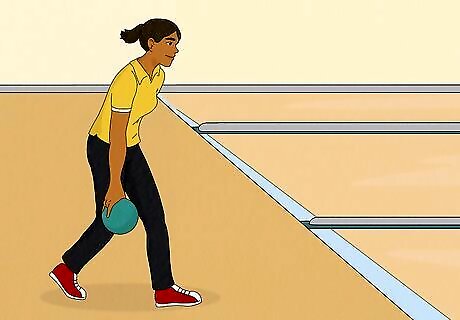
Take 3-4 fluid steps towards the lane. Start with the foot on the same side of your body as your bowling arm for traditional 4-step approach. If you think you might be more comfortable with a short 3-step approach, lead with the foot opposite your bowling arm instead. Most bowling instructors and pros recommend a basic 4-step approach, but you can add or subtract a step, if you like. What matters most is that the movement feels natural. Be careful not to cross the foul line by accident. If you do so during an actual game, your shot won’t count, no matter how many pins you manage to topple! Coordinating your steps will ensure that you end up in a balanced stance upon your release.
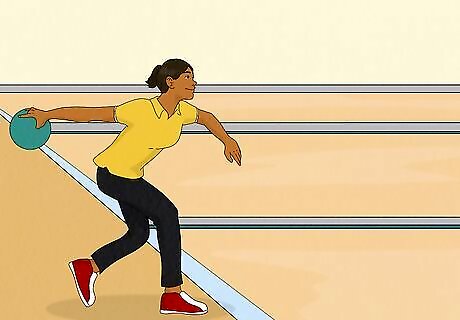
Swing the ball back behind you as you move closer to the pins. On your first or second step, lower the ball down from its ready position and let it travel back, up, and slightly out to the side. Continue lifting it until it’s roughly at shoulder height. From there, you'll be ready to uncork a thunderous strike! Ideally, your walk-up and your swing should flow together as one continuous motion. Each action should start and end at the same time.Tip: For a smoother swing, keep your entire arm straight from wrist to shoulder as you enter your downward descent and prepare to release the ball.
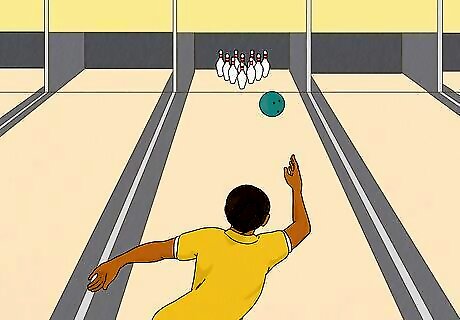
Keep your eyes on the pins at all times. Zero in on the center pin to give yourself a wide margin of error for your shot. You’re essentially relying on hand-eye coordination here to carry the ball from one end of the lane to the other with as little deviation as possible. Don’t overthink your aim. Just focus on your form and let the rest happen on its own. Once you start to get a feel for your technique, you can begin using the target arrows painted on the lane for reference. Adjusting your release for a slightly closer target will improve your accuracy.
Releasing the Ball
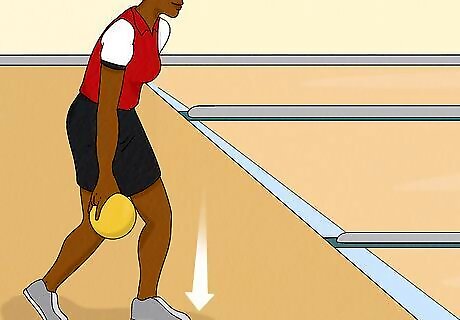
Lower your weight on the last step of your approach to get closer to the lane. Plant both feet firmly, bend the knee of your support leg, and lean forward at the waist slightly. Make sure your hips stay under your shoulders so that your whole body remains in alignment. The foot opposite your bowling arm should be in front of you as you begin your release. Getting low will put you in a better position to release the ball just above the surface of the lane, as opposed to dropping or chucking it from higher up. That way, it won’t come crashing down heavily, which can kill the momentum you’ve built up.Tip: Experienced bowlers typically cross their back leg behind their support leg during their release, almost like a curtsy. The advantage of this is that it counterbalances the force of the swing and keeps your hips open and square with the pins.
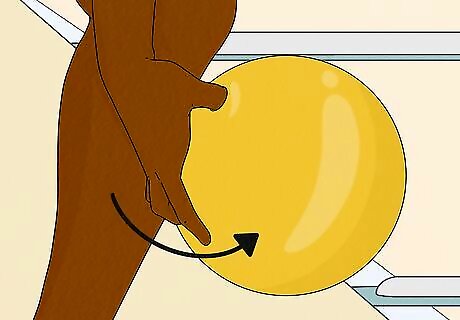
Curl your wrist inward or outward to compensate for varying lane conditions. In most cases, keeping the wrist of your bowling arm firm and straight is the key to a solid shot. If the lane is freshly-oiled, however, “loading” the ball by curving your wrist towards your forearm just a tad will allow you to cup the ball more firmly and give you a little more control. Similarly, you can “unload” the ball by bending your wrist back to create more snap when the lane looks especially dry. Loading and unloading both require subtle changes in technique. If your wrist is bent more than about 45 degrees in either direction, you may just sabotage your own shot. It’s good to get in the habit of inspecting the lane up close before you start your first game. Just like in golf, the conditions of your playing surface can have a huge influence on the way you bowl.
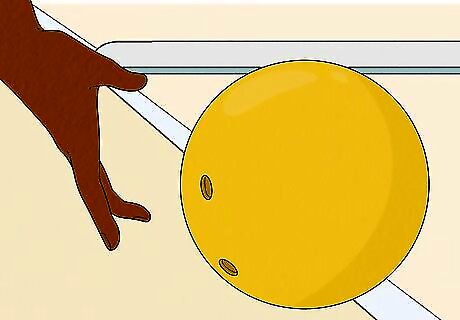
Let the ball slip off your fingers as it comes parallel with the lane. Simply uncurl your top two fingers and allow the momentum of your swing to carry the ball away from your hand. A delicate release will guarantee the smoothest possible transition to the lane. As your thumb leaves its hole, point it in the direction that you want the ball to go to help “steer” it a bit.
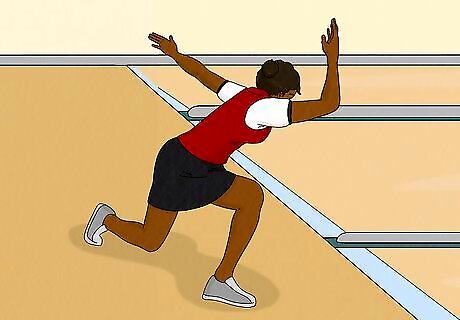
Continue extending your bowling arm upwards for greater speed and precision. Rather than dropping your arm as soon as you release the ball, keep following through to generate even more power. End your throw with your hand over your head, palm facing towards you. If an exaggerated follow-through feels awkward, aim to finish with your arm at around waist level, as though you were reaching out to shake someone’s hand. Don’t alter your stance or posture until the ball has left your hand completely, as the slightest shift could throw off your shot.
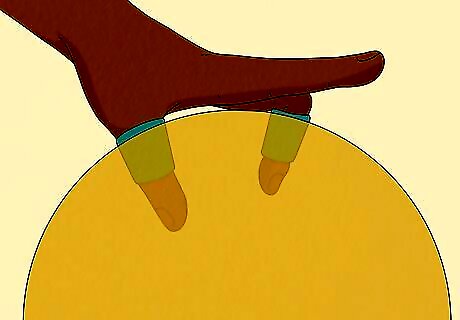
Try out a fingertip grip if the ball is getting stuck on your fingers. The fingertip grip is almost identical to the standard conventional grip. Instead of sliding your middle and ring fingers all the way into the holes, though, only insert them up to the first knuckle. A shallower grip will ensure that the ball has no difficulty leaving your hand. In general, it takes more finger strength to hold and manipulate the ball with a fingertip grip than with a conventional grip. The fingertip grip is considered an advanced technique, which means that it may make it harder for you to bowl accurately if you haven't yet mastered the conventional grip.
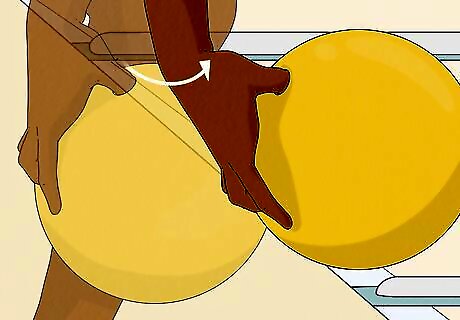
Learn to throw a hook when you get comfortable with straight shots. If your goal is to score big, you’ll eventually need to advance to the hook shot. To throw an effective hook, rotate your wrist inward sharply at the moment of release. If you do this just right, the circular motion will cause the ball to curve in a gentle arc. The straight shot is the first technique that every bowler learns, but its use is somewhat limited in competitive play, since it's prone to creating splits, or areas where the pins are separated by a gap. Splits can be tough to “pick up,” even for experienced bowlers. Adding the hook shot to your repertoire is a must if you want to be able to bowl strikes consistently. The curved ball path gives you access to the “pocket,” or the sweet spot between the 1-pin and 2- or 3-pin where all 10 pins are most likely to fall if struck hard enough.



















Comments
0 comment